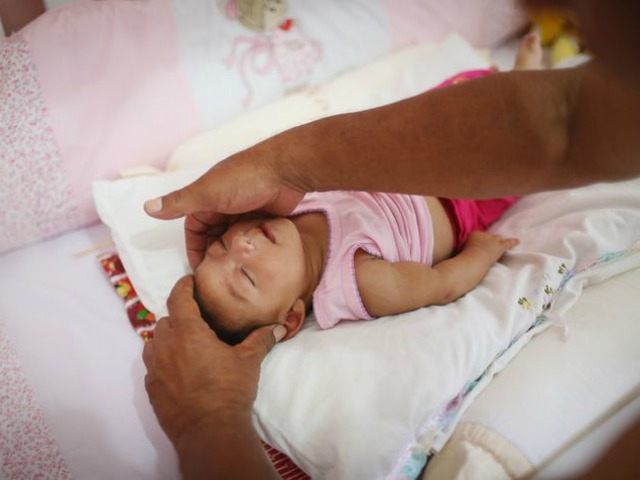Doctors in Brazil have discovered hydrocephalus in two babies with congenital malformation. Some suspect the ongoing Zika pandemic in the country caused these cases.
“It is not usual, in cases of congenital infection, to have microcephaly that develops into hydrocephalus,” said Dr. Vanessa Van Der Linden, a doctor in Recife, Pernambuco. “It serves as a warning. Now we need to investigate to understand what mechanism triggered hydrocephalus.”
Doctors define hydrocephalus as a “buildup of fluid in the cavities (ventricles) deep with the brain.” The excess fluid puts too much pressure on the brain, which “can damage brain tissues and cause a large spectrum of impairments in brain function.”
Medical professionals performed surgery on one child, aged three months. They inserted a valve to drain the fluid from the baby’s head.
Pernambuco state said it is too soon to connect hydrocephalus to Zika. The Brazilian Health Ministry admitted that “these are not the first reported cases and that, so far, there is no evidence [of a] relationship with Zika.”
The Zika outbreak has led to numerous discoveries of microcephaly, which occurs when the brain does not form properly during pregnancy or after birth. The disorder results in a small head with side effects such as seizures, developmental delays, intellectual disability, feeding problems, and visual problems.
The CDC states rubella, toxoplasmosis, cytomegalovirus, severe malnutrition, alcohol, drugs, and toxic chemicals can cause microcephaly.
Brazil has discovered more than 4,000 cases and is diagnosing an average of 200 cases a week. In 2015, the country tracked over 2,400 cases compared to the 147 in 2014. Doctors reported 404 cases of microcephaly in newborns since November. They tied seventeen “to the Zika virus.” Fifteen of the 404 passed away, “with five linked to Zika.” Authorities are investigating 56 other deaths and 3,670 cases.
In Seattle, a family shared their experience with microcephaly after the outbreak brought attention to the disorder. Doctors diagnosed their daughter Isla Rose with microcephaly. Her mother “contracted CMV during pregnancy.” The microcephaly caused hydrocephalus in Isla, along with “profound hearing loss.” The two-year-old cannot “hold up her own head, had poor muscle tone and must use a feeding tube.” A doctor advised to couple to have an abortion, but they said no.
Planned Parenthood and leftist activists have argued that easier access to abortion will help contain the damage the Zika virus is causing in Latin America.
“It is essential to recognize that women and men have the right to make decisions and existential options and one of the most important choices in the life of a woman is to have children or not,” sociologist Jacqueline Pitanguy wrote in O Globo.
Fear of microcephaly or other complications due to Zika has pushed women to choose illegal abortions. Doctors indicate women in all social classes are seeking out these abortions “in despair over the possibility of deformity.” Some even go through with abortions without concrete proof of complications.
Doctors cannot diagnose microcephaly until the third trimester or after birth:
In many cases, microcephaly may not be evident by ultrasound until the third trimester and, therefore, may not be seen on ultrasounds performed earlier in pregnancy. The diagnosis of microcephaly may be made at birth or later in infancy. The baby’s head circumference is much smaller than normal. During the physical exam, the doctor obtains a complete prenatal and birth history of the child. In older babies and children, the doctor may also ask if there is a family history of microcephaly or other medical problems. Sometimes the child is born with a normal head circumference but then acquires microcephaly because of a serious condition, such as certain genetic disorders, stroke, traumatic injury, or poisoning. The doctor will also ask about developmental milestones since microcephaly can be associated with other problems, such as intellectual disability. Developmental delays may require further medical follow-up for underlying problems.
Brazil has outlawed abortion except in cases of rape, incest, or when the mother’s life is in danger, and a judge must approve each case.
The Brazilian Conference of Catholic Bishops has rejected the left’s attempt to promote abortion in areas affected by Zika.
The bishops acknowledge the “virus deserves special attention by its probable link to microcephaly,” but insist it is unacceptable to immediately jump to abortion.
“The alert, however, should not panic us,” they wrote. “Nor use it to justify abortion for cases of microcephaly as proposed regrettably by certain groups that organize to take the matter to the Supreme Court, a total disrespect for the gift of life.”

COMMENTS
Please let us know if you're having issues with commenting.